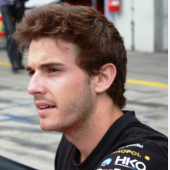The 9 Worst Formula 1 Crashes in F1 History

- The 1955 Monaco GP saw one of the worst Formula One crashes as Alberto Ascari’s car was submerged.
- During the 1978 Italian GP, Ronnie Peterson suffered 27 fractures to his lower extremities and died.
- Even with improved safety measures, Romain Grosjean gave everyone a scare at the 2020 Bahrain GP.
In Formula One, we don’t see a lot of crashes. However, we’ve seen some horrific Formula One crashes over the years. The cars are much smaller than a stock car, so their speeds reach 200 miles per hour.
Some of these crashes were significant enough to cost a driver their life. Because of that, we won’t rank those accidents. Instead, we’ll go in chronological order.
Here are the 10 worst F1 crashes in Formula 1’s history.
1955 Monaco Grand Prix – Alberto Ascari
If you’re wondering what the worst Formula One crashes are in history, let’s go back to 1955 to get things started. Perhaps the weirdest crash in F1 history took place during the 1955 Monaco Grand Prix.
Two-time World Champion Alberto Ascari started the race in the second row. He battled throughout the race with J.M. Fangio and Stirling Moss. Fangio exited with transmission problems, leaving Ascari and Moss to battle for the lead.
On lap 80, Moss’ car suffered an engine failure. Ascari should’ve come around to take the lead, but he didn’t make it past the pits. His car missed a chicane and went straight through a barrier for whatever reason. His car went over the wall and into the Mediterranean Sea.
Yes, he was in the water.
His car disappeared from the public as everyone feared the worst. Thankfully, he came above water and swam to a nearby boat. Surprisingly, he only suffered a broken nose.
It was miraculous to see him walk away with a minor injury. I mean, his car went into the water, for crying out loud. I imagine that’s tough to escape from.
What’s so unfortunate about this whole situation is Ascari died a few days later in a testing crash. The crash was isolated from his wreck at the Monaco Grand Prix.
1961 Italian Grand Prix – Wolfgang von Trips
In 1961, the Italian Grand Prix was the second to last race. Four drivers fought for the championship, including Wolfgang von Trips and Phil Hill. Von Trips started on the pole, with Hill starting fourth.
The Italian Grand Prix at Monza featured high banking corners, allowing for high speeds down the front stretch. At the end of lap two, von Trips’ car made contact with Jim Clark. The contact caused von Trips’ car to turn left and go straight up a hill.
On top of the hill were fans watching the action. Unfortunately, the car struck spectators, killing 15 people. Von Trips’ car hit a fence and went airborne. He lost his life after being thrown from the vehicle.
For some reason, Formula One opted to continue the race. Hill claimed the victory and the championship.
This was the final time Formula One raced on that layout. They removed the oval portion of the circuit, which eliminated the high-banked corners. That was a smart move because those cars can go way too fast with those corners. This Formula 1 crash showed how dangerous they could be.
That change likely avoided more tragic events.
1976 German Grand Prix – Niki Lauda
Most people referred to the Nürburgring circuit as one of the most dangerous tracks in the 1970s. And that was on a clean track. The 1976 German Grand Prix didn’t have that.
There was rain before the race, which led to canceling the race. Niki Lauda was one of the drivers who voted against running the race. However, the drivers voted in favor of the race, and it went on as scheduled.
Following the first lap, most drivers pitted to put on dry tires as the rain went away. Lauda’s car had just cleared a left kink on the second lap. His car snapped to the right and went head-on into the wall as he entered the straightaway.
His car burst into flames, and he couldn’t exit on his own. Luckily, a few drivers were able to help him escape the fire.
Lauda suffered severe burns to his body and later lapsed into a coma. Miraculously, Lauda recovered from the crash and returned to racing six weeks later. Not only did he return to Formula One, but he won two championships before the end of his career.
It was indeed a remarkable comeback, but it followed one of the worst F1 crashes in history.
1978 Italian Grand Prix – Ronnie Peterson
The 1978 Italian Grand Prix was one of the season’s final races. Mario Andretti led the standings, with Ronnie Peterson and Niki Lauda close behind.
After suffering a crash in practice, Peterson had a rough start to the weekend. He had to start the race with an older model car.
It was a weird start to the race, as the green light came on before all the cars were on the line. That meant the drivers in the back had a running start. With differing speeds, James Hunt crashed into the back of Peterson’s car. That caused Peterson’s car to veer right into the barrier.
Peterson’s car burst into flames, with him momentarily trapped inside. A few drivers, including Hunt, could free him so medical officials could tend to him.
X-Rays revealed that Peterson suffered 27 fractures in his legs and feet in the hospital. Even with the injuries, it appeared Peterson would survive the crash. Unfortunately, his condition took a turn for the worst overnight. He was declared dead the following morning.
This is such a tragic event because it was avoidable. The technical error with the green light led to the opening-lap chaos. Without it, there’s likely no crash, and this one doesn’t end up on my list of scariest F1 crashes of all-time.
1982 Belgian Grand Prix – Gilles Villeneuve
In 1982, Gilles Villeneuve was one of the most popular drivers in Formula One. The Belgian Grand Prix marked the fifth race of the season.
Before every race, drivers will engage in a qualifying session to set the starting lineup. In the final qualifying session, Villeneuve was 0.1 seconds behind Didier Pironi for sixth place. Villeneuve returned to the track looking to improve his time.
He came over a hill and approached a much slower car. There was some confusion as to which side Villeneuve should pass on. That led to him rear-ending the car, sending him airborne.
Safety officials took Villeneuve away on a helicopter, but he had a fatal neck fracture. He was on life support before dying later that evening.
It’s no doubt one of the worst F1 crashes I’ve ever seen. Watching his body fly from the car is horrifying. Thankfully, we’ve seen safety come a long way to prevent that from happening in the future.
1994 San Marino Grand Prix – Roland Ratzenberger
Everyone will remember the 1994 San Marino Grand Prix for a pair of tragic accidents. The first came in a qualifying session.
Roland Ratzenberger was in his first season and attempting to qualify for his third race. Ratzenberger missed a corner and slammed straight into a concrete barrier. His car slid down the track and into the next turn.
His car went into the barrier at speeds north of 190 miles per hour.
It was a scary scene as Ratzenberger’s head leaned over in his car. Medical officials rushed to the car, but they could do nothing. Ratzenberger suffered a basal skull fracture, resulting in his death.
What’s sad about the crash is that it could’ve been prevented. On the lap before, he hit a curb, suffering damage to his front wing. Instead of bringing the car down pit road, Ratzenberger opted to go for one more lap.
That lap was where his front wing failed, leaving Ratzenberger without control of his car.
Unfortunately, this wasn’t the only tragic event from the weekend. Rubens Barrichello crashed the day before, resulting in a broken arm and nose. Then, we had the tragedy from the race on Sunday.
1994 San Marino Grand Prix – Ayrton Senna
Ayrton Senna is one of the greatest drivers in Formula One history. Senna won three championships from 1988-1991.
Senna switched teams in the offseason, and he wasn’t off to a great start in 1994. Following Ronald Ratzenberger’s fatal crash, neurosurgeon Sid Watkins told Senna that he didn’t need to race anymore. Senna brushed him off and wanted to continue his career.
He started on the pole for the 1994 San Marino Grand Prix. On lap seven, he had a slight lead over Michael Schumacher. Senna came up on a left turn but couldn’t turn his car and went straight into the wall.
Senna was able to slow down his car, but he still hit a concrete wall at 130 miles per hour.
When Senna hit the wall, his right front wheel came up into the cockpit, striking him in the head. Unfortunately, that was a fatal blow, as he suffered a skull fracture. He also had considerable blood loss from a piece of debris that pierced through his helmet.
A silver lining to his tragedy brought on better safety protocols if there is a silver lining. Those safety measures likely prevented many injuries and saved a few lives.
2014 Japan Grand Prix – Jules Bianchi

The enhanced safety measures from the 1994 San Marino Grand Prix prevented another racing death for 20 years. Unfortunately, we saw another tragedy in the 2014 Japan Grand Prix.
The weather was a significant factor in the race, as rain affected the track conditions. Adrian Sutil spun off the track on lap 42. A crane removed Sutil’s car from the corner when Jules Bianchi went straight through the corner and into the crane.
The crash destroyed his roll bar, making the car slide underneath the crane.
Bianchi was unconscious as safety officials removed him from his car. Because of the weather, they couldn’t fly him to the hospital. Bianchi suffered a severe head injury and underwent surgery.
He remained in the hospital for months, but his condition didn’t improve. Bianchi died on July 17, 2015, a little over nine months after his crash in Japan.
There was a lot of controversy surrounding the accident. Some believed the officials made a mistake waving a green flag through that area, while others felt there should’ve been a safety car.
Bianchi’s crash led to Formula One implementing closed cockpits. A closed cockpit could’ve at least led to a less severe injury in this incident.
2020 Bahrain Grand Prix – Romain Grosjean
We don’t see a lot of bad Formula One crashes in today’s era, but Romain Grosjean gave us quite a scare at the 2020 Bahrain Grand Prix.
On the first lap of the race, there was a bit of a stack up in the back of the pack. Grosjean clipped the front of Daniil Kvyat’s car, sending Grosjean into a fence at 119 miles per hour.
The angle he hit the fence caused his car to split in half and burst into flames.
You see a crash like that and immediately think the worst. His car was in two pieces and surrounded by fire. Nobody wants to think the worst, but there were a lot of fans fearful for his condition.
Thankfully, the driver compartment stayed intact. The halo device was also a critical factor in avoiding a severe head injury. Formula One mandated it in 2018, and it has already saved multiple drivers from a significant injury.
Grosjean had this to say about the device – “I think it’s the greatest thing that we’ve brought to Formula 1, and without it, I wouldn’t be able to speak with you today.”
Grosjean suffered second-degree burns, but that was the extent of it. An unbelievable feat considering the severity of his accident.
Remembering the Scariest Formula One Crashes

Hopefully, I’ve shown you what some of the worst F1 crashes are with the breakdown above. This is an amazing spot, but judging by it’s history, it’s also highly dangerous.
Formula One has seen way too many tragic accidents. The one positive takeaway is that every bad F1 crash increases safety and avoids future tragedies.
There’s a reason we’ve only seen one fatal crash since 1994. That has to make the drivers and fans feel safe with any Formula One race.
One more positive is that you can bet on F1 races. If you’re interested in doing so, just visit take a look at our guide below for the the top F1 betting sites you can find online.
Footnote:
- Autoweek discusses how the 1976 German Grand Prix changed how people raced at Nurburgring Nordschleife.
 75%
75% 80%
80%
